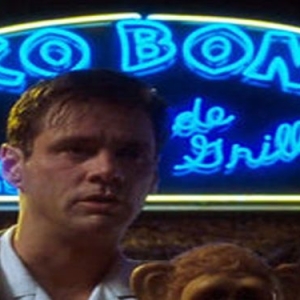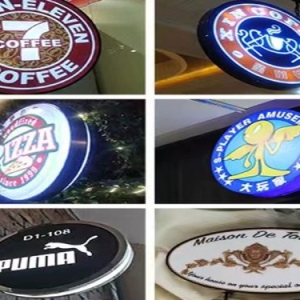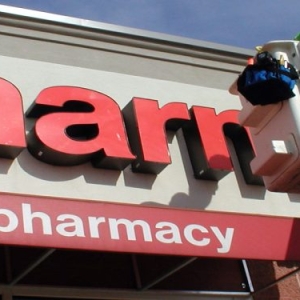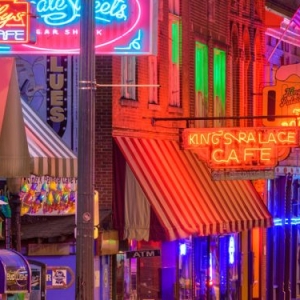Introduction
In our daily life and business activities, all kinds of signs and signages are beautiful. It takes some professional knowledge to tell at a glance what materials they are made of.
In this article, we specially sorted out the commonly used backboard materials for making signs and signages. If you think they are good, remember to collect them and don’t forget to share them!
Wood Material

Wood has a long history of use as a material for signboards, and it has always been one of the mainstream materials from ancient times to the present.

Nowadays, wooden signs are widely used in parks, scenic spots and other places. Because of their texture, these signs always give passers-by a feeling of being close to nature and returning to tradition. Good wood is expensive and not environmentally friendly; although ordinary wood is cheaper, it is easily affected by natural factors and may deform, crack and other problems.
Commonly used wood materials include walnut, bologna, rosewood, etc.
Stone Materials

Stone, like wood, has a long history of use. It is not easily damaged in the natural environment and has a long service life.
Similar to wood, stone has a very good texture effect, unique style, and rich cultural flavor, which cannot be replaced by other materials.
However, the biggest disadvantage of stone is that the material itself is too heavy, which is not conducive to processing, and there are many structural issues that need to be considered. Commonly used stones include bluestone, granite, marble, etc.
Metal Materials
Aluminum Alloy

In modern sign systems, aluminum alloy signs generally refer to signs made of aluminum alloy and modular in structure, which facilitates unification and standardization.
Advantages of aluminum alloy:
Good texture, slow oxidation, light texture, stylish and neat appearance,
High plate thickness, good flatness,
Strong coloring adhesion, firm and durable, not easy to fade
Easy to install
Low cost.
If the structure is reasonably designed, it is also easy to replace.
Stainless Steel Plate


Generally, stainless steel signs have the following features after laser cutting, chemical corrosion, spray printing, engraving, and other processing technologies.
Commonly available are bright and matte. Stainless steel has good texture, and slow oxidation, often in natural color, conveying a stylish, connotative, elegant, and noble temperament.
The disadvantages of stainless steel plates are high material costs, darker and more monotonous colors, and poor effects on rainy days. They are usually used for building signs, corporate image signs, etc., and can also be used in combination with other materials to achieve good results.
Cold-rolled Steel Plate

The biggest feature of cold-rolled steel plate is its strong plasticity, easy bending, cutting, welding, grinding, convenient processing, strong coloring adhesion, and can be used to make various shapes.
The disadvantage is that it oxidizes quickly and is easy to rust, so surface texture treatment is very important.
Cold plate is widely used due to its low material cost.
However, the surface baking paint must be strictly controlled and cannot be replaced by spray painting. There will also be some phenomena of insufficient baking paint procedures and inferior products.
Galvanized Sheet

Electro-galvanized steel sheet, also known as electrolytic sheet, is a process of forming a uniform, dense, well-bonded metal or alloy deposition layer on the surface of the workpiece through an electrolytic process.
This steel sheet is not only corrosion-resistant, but also maintains good processability. It is widely used in many fields such as construction, home appliances, vehicles and ships, container manufacturing, the electromechanical industry, the advertising industry, etc.
In the advertising industry, galvanized illuminated letters are widely used and are well-received by users.
Synthetic Materials
Common ones include acrylic board, fiberglass, aluminum-plastic board, PVC board, sun board, hibiscus board, etc. The characteristics are novel personality, strong sense of fashion, simple construction structure, and low material cost.
There are many types of synthetic materials, and their performances are also different. Therefore, when choosing, you must understand their respective characteristics in detail and select materials rationally and scientifically.
PVC

Also known as Chevron board, rigid PVC is the most widely used. PVC material is non-flammable, high-strength, strong weather resistance and excellent geometric stability, and has strong resistance to oxidants, reducing agents and strong acids.
The melting temperature of PVC is a very important process parameter during processing. If this parameter is improper, the material will decompose.
The heating temperature should be between 70 degrees Celsius and 120 degrees Celsius, which is suitable for the processing and production of Chevron board.
Within this temperature range, Chevron board can maintain good physical properties and chemical stability, ensuring the smooth progress of the processing and the quality of the finished product.
Acrylic

Acrylic in English is a chemical material, known as “plastic crystal”.
Acrylic has excellent weather resistance, especially suitable for outdoor use. It has good surface hardness and gloss, and has great processing plasticity, and can be made into various required shapes and products.
Organic Sheet
Relatively thin and plastic. Lightweight and inexpensive, with excellent electrical insulation, certain impact resistance, weather resistance and aging resistance, good light transmittance, and resistance to general chemical corrosion.
The price is lower than acrylic, and it can be machined, hot-bent, silk-screened, and blister-formed.
Flowboard

It is a new type of chemical board with a smooth surface and a certain hardness.
Its characteristics are: no water absorption, no decomposition, no rain, moisture, no rot, anti-aging, anti-ultraviolet radiation, oil, acid, alkali and other chemical corrosion, and sound insulation, sound absorption, heat insulation and other properties. The product is light in texture and easy to store, transport, construct, cut and carve.
In the field of signs and signage, Flowboard is mainly used for cutting fonts and logos to create a three-dimensional effect. Black and white boards are used in large quantities. After the shapes are cut out, they are sprayed with colored paint, which has a good effect and saves time and money.
KT Board (Karat Board)
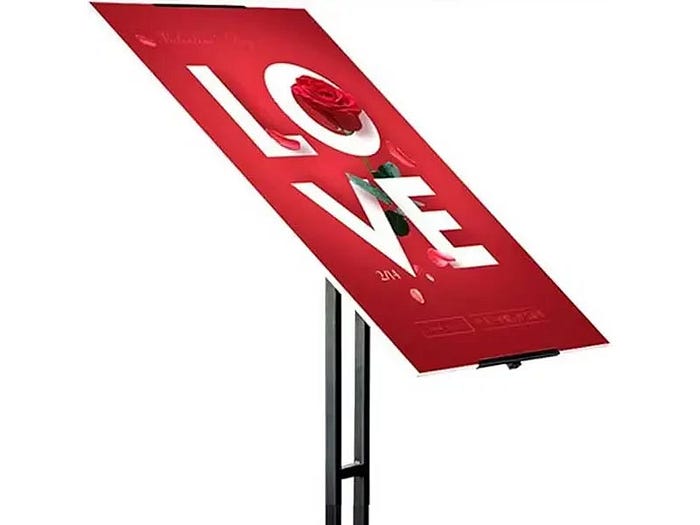
The word KT board is currently only used in China and the United States (KT board). Other countries basically call it foam board, which means foam board or poster board.
KT board is a new type of material made of PS particles through foaming to form a board core, and then coated and pressed on the surface. The board is crisp, light, not easy to deteriorate and easy to process.
Aluminum Composite Panel

Aluminum Composite Panel are made of polyethylene plastic and aluminum through a special process. They are a composite material consisting of two layers of aluminum plates and a plastic layer in the middle. Commonly used plastic materials include polyethylene (PE) and polyvinyl chloride (PVC).
Aluminum-plastic panels are waterproof, moisture-proof, corrosion-resistant, and flame-retardant. They have a smooth surface and rich colors, and are suitable for a variety of printing methods such as spraying, silk-screen printing, and digital direct printing.
Aluminum-plastic panels are widely used in outdoor billboards, exhibition display boards, traffic signs, and other fields.
Glass Material

Laminated glass is a composite glass product that is made of two or more pieces of glass with one or more layers of organic polymer interlayer sandwiched between them. After special high-temperature pre-pressing (or vacuuming) and high-temperature and high-pressure processing, the glass and the interlayer are permanently bonded together. Common organic polymer interlayers include PVB, SGP, EVA, PU, etc.
Laminated glass has high security and sound insulation effects, and has the characteristics of bulletproof, anti-theft, UV protection, and sound insulation. It has a smooth surface, high transparency, and rich colors, and is suitable for printing methods such as silk screen printing and digital direct printing. Laminated glass is widely used in high-end shops, financial institutions, museums and other fields.
Conclusion
Good signage products are based on good materials, but they also depend on the grasp of material properties and the rational application of materials with skilled techniques, and of course, they are inseparable from the understanding of customer needs.


